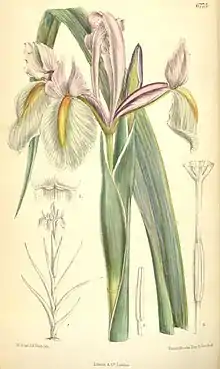| Iris tingitana | |
|---|---|
 | |
| Scientific classification | |
| Kingdom: | Plantae |
| Clade: | Tracheophytes |
| Clade: | Angiosperms |
| Clade: | Monocots |
| Order: | Asparagales |
| Family: | Iridaceae |
| Genus: | Iris |
| Subgenus: | Iris subg. Xiphium |
| Section: | Iris sect. Xiphium |
| Species: | I. tingitana |
| Binomial name | |
| Iris tingitana | |
| Synonyms[1] | |
| |
Iris tingitana (also commonly known as the Morocco iris,[2] or Tangerian iris,[3] or Tangiers iris[4]) is a species in the genus Iris in the subgenus of Xiphium.
Description
The 1.5 in (38 mm) (diameter) bulb is red-brown in colour with veining.[5]
The largest bulbs of the Iris subg. Xiphium subgenus are Iris tingitana.[6] In the US, bulbs with an 11 cm circumference are recommended to be used by flower producers.[6]
It has flowers in various shades of blue.[7] It has pale blue veins on the flowers and has generally between 1 and 2 flowers to a stem.[8] The stems is hidden by two channelled leaves.[5]
It blooms between February and May.[7] The plant can grow to a maximum height of 60 cm (24 in) and its leaves appear in the autumn.[8] They can grow up to 1 1/2 ft high.[5]
Biochemistry
'Iriskumaonin' (C18H24O7 is found within the bulbs of Iris tingitana, as well as Iris germanica and Iris kemaonensis.[9]
Taxonomy
The name is derived from 'tingitana' from the Greek word meaning 'from Tangiers'.[10] It is pronounced 'ting-ee-TAN-uh'[2]
It is often mistakenly called 'Spanish Iris'.[11] The Spanish Iris is Iris xiphium.
It was first published and described by Pierre Edmond Boissier and George François Reuter in 'Pugillus Plantarum Novarum Africae Borealis Hispaniaeque Australis' (Pugill. Pl. Afr. Bor. Hispan.) Vol. 113 in January 1852.[12][13]
It was then illustrated in Curtis's Botanical Magazine, Tab. 6775 on 1 September 1884.[14]
It was verified by United States Department of Agriculture and the Agricultural Research Service on 4 April 2003, then updated on 14 April 2009.[13]
Distribution and habitat
Range
It is found in Morocco and Algeria.[8][13] It is also found in North Africa, Spain and Portugal.[7]
Conservation
In 2014, it was becoming rare in Morocco.[15]
Cultivation
It is very susceptible to iris mosaic virus.[16]
It can be propagated by bulblets, 1 to 4 small bulbs growing beside the main bulb which can then be taken off and planted to grow on to form a new bulb.[6]
It has a reputation of being a difficult species to grow in the UK.[8] Even in the US, it is restricted to be grown in mild climates such as southern California.[6] Due to the limited hardiness of the species, it is better grown in a bulb frame or grown in a dry border then lifted and stored like dahlias.[7]
It can be grown in pots for inside or outside displays.[17]
Cultivars
Known cultivars include; Iris tingitana 'Paris' (large dark blue violet flowers)[18]
References
- ↑ "Iris tingitana Boiss. & Reut. is an accepted name". theplantlist.org. 23 March 2014. Retrieved 19 November 2014.
- 1 2 "PlantFiles: Moroccan Iris". davesgarden.com. Retrieved 2 August 2014.
- 1 2 "Iris tingitana". www.rhs.org.uk. Retrieved 1 August 2014.
- ↑ Donald Wyman Wyman's Gardening Encyclopedia, p. 577, at Google Books
- 1 2 3 Richard Lynch The Book of the Iris, p. 159, at Google Books
- 1 2 3 4 Griffiths, David (April 1928). "Production of certain Iris bulbs". Retrieved 30 July 2014.
- 1 2 3 4 Austin, Claire (2005). Irises: A Gardener's Encyclopedia. Timber Press, Incorporated. ISBN 978-0881927306. OL 8176432M.
- 1 2 3 4 Cassidy, G.E.; Linnegar, S. (1987). Growing Irises (Revised ed.). Bromley: Christopher Helm. pp. 144–145. ISBN 0-88192-089-4.
- ↑ John Buckingham, V. Ranjit N. Munasinghe Dictionary of Flavonoids with CD-ROM, p. 640, at Google Books
- ↑ Stearn, William (1972). A Gardenerer's Dictionary of Plant Names. London: Cassell. p. 315. ISBN 0304937215.
- ↑ "Iris filifolia". www.webster-dictionary.org. Retrieved 1 August 2014.
- ↑ "Iridaceae Iris tingitana Boiss. & Reut". ipni.org (International Plant Names Index). Retrieved 10 August 2015.
- 1 2 3 4 "Iris tingitana". Germplasm Resources Information Network. Agricultural Research Service, United States Department of Agriculture. Retrieved 10 August 2015.
- ↑ "Curtis's Botanical Magazine". www.biodiversitylibrary.org. p. 141. Retrieved 1 August 2014.
- ↑ Codrington, Tessa (2 August 2014). "Tangiers is booming". www.spectator.co.uk (The Spectator). Archived from the original on 24 September 2015. Retrieved 3 August 2014.
- ↑ Kenneth M. Smith A Textbook of Plant Virus Diseases, p. 306, at Google Books
- ↑ "Iris tingitana". 17 February 1938. p. 6. Retrieved 1 August 2014.
- ↑ "Iris plant named Paris". 10 April 1988. Retrieved 1 August 2014.
Other sources
- Jahandiez, E. & R. Maire. 1931–1941. Catalogue des plantes du Maroc.
- Maire, R. C. J. E. et al. 1952–. Flore de l'Afrique du Nord.
- Mathew, B. 1981. The Iris. 137–138.
- Tutin, T. G. et al., eds. 1964–1980. Flora europaea. [mentions].
External links
![]() Media related to Iris tingitana at Wikimedia Commons
Media related to Iris tingitana at Wikimedia Commons
![]() Data related to Iris tingitana at Wikispecies
Data related to Iris tingitana at Wikispecies